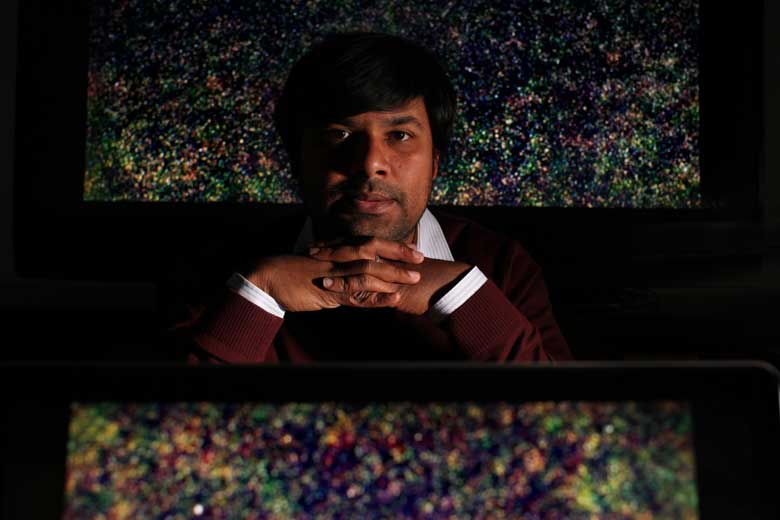The result is that scientists are discovering hundreds of new galaxies through brighter galaxies in front of them that deflect their faint light back to the massive Herschel telescope, an effect identified by Albert Einstein a century ago known as cosmic gravitational lensing.
When such a lineup occurs, it creates a cosmic magnifying lens, with a massive galaxy or cluster of galaxies bending light from the more distant galaxy into a warped and enlarged image. Sometimes, light from the farther galaxy is so distorted that it appears as a ring – called an Einstein ring because he first predicted the phenomenon. The effect is similar to what happens when you look through the bottom of a glass bottle or into a fun house mirror.
The new galaxies are in the far reaches of outer space and are being viewed at a time when the universe was only 2 billion to 4 billion years old, less than a third of its current age. The galaxies have dust so thick they cannot be seen at all with visible-light telescopes but Herschel can detect the faint warmth of the dust because it glows at far-infrared and sub-millimeter wavelengths. With these galaxies magnified, astronomers can dig deep into their dusty reaches to learn more about how the universe was created.

University of California-Irvine astronomer Asantha Cooray in front of an image of galaxies he and the team helped unearth with the Herschel telescope. Credit: Michelle S. Kim / University Communications
A new study reports that five new galaxies have been found using this technique, but astronomers suspect they've just scratched the surface. "We can probably pick out hundreds of new lensed galaxies in the Herschel data," said Paul Goldsmith, the U.S. project scientist for Herschel at NASA's Jet Propulsion Laboratory in Pasadena. The researchers estimate that 200 more have been discovered since the article went to press, all awaiting confirmation by ground-based telescopes.
Numerous telescopes around the world helped verify the initial findings, including the National Radio Astronomy Observatory's Green Bank Telescope in West Virginia and three telescopes in Hawaii at the W.M. Keck Observatory, the California Institute of Technology's Submillimeter Observatory and the Smithsonian Astrophysical Observatory's Submillimeter Array.
Citation: Mattia Negrello, R. Hopwood, G. De Zotti, A. Cooray, A. Verma, J. Bock, D. T. Frayer, M. A. Gurwell, A. Omont, R. Neri, H. Dannerbauer, L. L. Leeuw, E. Barton, J. Cooke, S. Kim, E. da Cunha, G. Rodighiero, P. Cox, D. G. Bonfield, M. J. Jarvis, S. Serjeant, R. J. Ivison, S. Dye, I. Aretxaga, D. H. Hughes, E. Ibar, F. Bertoldi, I. Valtchanov, S. Eales, L. Dunne, S. P. Driver, R. Auld, S. Buttiglione, A. Cava, C. A. Grady, D. L. Clements, A. Dariush, J. Fritz, D. Hill, J. B. Hornbeck, L. Kelvin, G. Lagache, M. Lopez-Caniego, J. Gonzalez-Nuevo, S. Maddox, E. Pascale, M. Pohlen, E. E. Rigby, A. Robotham, C. Simpson, D. J. B. Smith, P. Temi, M. A. Thompson, B. E. Woodgate, D. G. York, J. E. Aguirre, A. Beelen, A. Blain, A. J. Baker, M. Birkinshaw, R. Blundell, C. M. Bradford, D. Burgarella, L. Danese, J. S. Dunlop, S. Fleuren, J. Glenn, A. I. Harris, J. Kamenetzky, R. E. Lupu, R. J. Maddalena, B. F. Madore, P. R. Maloney, H. Matsuhara, M. J. Michaowski, E. J. Murphy, B. J. Naylor, H. Nguyen, C. Popescu, S. Rawlings, D. Rigopoulou, D. Scott, K. S. Scott, M. Seibert, I. Smail, R. J. Tuffs, J. D. Vieira, P. P. van der Werf, and J. Zmuidzinas, 'The Detection of a Population of Submillimeter-Bright, Strongly Lensed Galaxies', Science 5 November 2010 330: 800-804 DOI: 10.1126/science.1193420






Comments